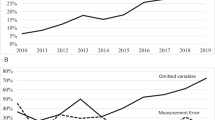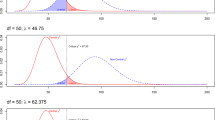Abstract
Fairness considerations often are invoked to explain wage differences that appear unrelated to worker characteristics or job conditions, but non-experimental tests of fair wage models are rare because market data rarely permit researchers to measure individual workers’ productivity and its value. We use data from the baseball labor market to address this problem, and find no support for fair wage theory. We do find, however, that fairness premia can be illusory: Wages appear to incorporate fairness premia in regressions that control for variation in individuals’ physical output, but such premia evaporate when the value of that output is held constant.
Similar content being viewed by others
Notes
Though it should be noted that if employers behave “irrationally”—if, e.g., they are willing to “pay any price to win”—and do not limit their wage offers to players’ MRPs in their market, the structure of wages may be markedly different from that described in the foregoing analysis.
It is not uncommon, however, for players to sacrifice some monetary income to play in markets pleasing to them for other reasons, e.g., proximity to their hometowns.
Of course, ten players may contribute at one time in the American League, thanks to that league’s Designated Hitter rule.
It should be noted also that Coasian sales of high-quality, low-seniority players from small- to large-market teams are prohibited by the sport’s Commissioner in order to “preserve competitive balance.”
An alternative approach suggested by the fairness literature would compare wages to firm profits, but measures of profits are notoriously unreliable in major league baseball, where, for a variety of reasons, team owners have a strong incentive to appear unprofitable (see e.g., Fort 2003, p. 117).
As it turns out, our results are identical to OLS because there was not a single sophomore player who was paid exactly the minimum salary. This indicates that while teams hold considerable monopsony power over pre-arbitration-eligible players, they either (a) bump wages above the minimum for fairness reasons or (b) pay players a share of their MRP as a result of bargaining by the players or their agents. Results for Eqs. 6 and 7 suggest the latter explanation.
James is a founding father of the field of “sabermetrics,” or the application of statistical methods to the study of baseball. His tools for evaluating player productivity are widely used by researchers, journalists, and teams themselves. The central virtue of the Win Shares measure is that it ignores no element of player performance that affects team success; that is also its main vice, since scores of formulae and hundreds of parameters are required to generate an accurate summary productivity measure. Clearly, however, it is far more accurate than the approximations sometimes used in the sports economics literature (see, e.g., Scully 1974).
See Griffiths et al. (1993, p. 435).
Results from regressions on the natural log of salary follow the same pattern of the results reported in Table 3.
References
Abowd JM, Kramarz F, Margolis DN (1999) High-wage workers and high-wage firms. Econometrica 67(2):251–334
Akerlof GA, Yellen JL (1990) The fair wage-effort hypothesis and unemployment. Q J Econ 105(2):255–83
Arai M (2003) Wages, profits, and capital intensity: evidence from matched worker-firm data. J Labor Econ 21(3):593–618
Blackburn M, Neumark D (1992) Unobserved ability, efficiency wages, and interindustry wage differentials. Q J Econ 107(4):1421–1436
Blanchflower DG, Oswald AJ, Sanfey P (1996) Wages, profits, and rent-sharing. Q J Econ 111(1):227–251
Blinder AS, Choi DH (1990) A shred of evidence on theories of wage stickiness. Q J Econ 105(4):1003–1015
Brown C, Medoff J (1989) The employer size-wage effect. J Polit Econ 97(5):1027–1059
Burger JD, Walters SJK (2003) Market size, pay, and performance: a general model and application to major league baseball. Journal of Sports Economics 4(2):108–125
Burger JD, Walters SJK (2005) Arbitrator bias and self-interest: lessons from the baseball labor market. J Labor Res 26(2):267–280
Ciccone A, Hall RE (1996) Productivity and the density of economic activity. Am Econ Rev 86(1):54–70
Dickens WT (1986) Wages, employment and the threat of collective action by workers. NBER working paper no. 1856, National Bureau of Economic Research, Cambridge, MA
Dickens WT, Katz LF (1987) Inter-industry wage differences and industry characteristics. In: Lang K, Leonard J (eds) Unemployment and the structure of labor markets. Blackwell, New York, pp 48–89
Fehr E, Kirchsteiger G, Riedl A (1993) Does fairness prevent market clearing? An experimental investigation. Q J Econ 108(2):437–459
Fort RD (2003) Sports economics. Prentice-Hall, Upper Saddle River, NJ
Gibbons R, Katz LF (1992) Does unmeasured ability explain inter-industry wage differentials? Rev Econ Stud 59(3):515–535
Glaeser EL, Mare DC (2001) Cities and skills. J Labor Econ 19(2):316–342
Griffiths WE, Hill RC, Judge GG (1993) Learning and practicing econometrics. Wiley, New York
Idson TL, Oi WY (1999) Workers are more productive in large firms. Am Econ Rev 89(2):104–108
James B (2002) Win shares. STATS, Morton Grove, IL
Kahneman D, Knetsch JL, Thaler R (1986) Fairness as a constraint on profit seeking: entitlements in the market. Am Econ Rev 76(4):728–741
Krueger AB, Summers LH (1988) Efficiency wages and the inter-industry wage structure. Econometrica 56(2):259–293
Lallemand T, Plasman R, Rycx F (2004) Intra-firm wage dispersion and firm performance: evidence from linked employer–employee data. Kyklos 57(4):533–558
Lawler EE, O’Gara PW (1967) The effects of inequity produced by underpayment on work output, work quality and attitudes toward the work. J Appl Psychol 51(5):403–410
Levin RC, Mitchell GJ, Volcker PA, Will GF (2000) The report of the independent members of the commissioner’s blue ribbon panel on baseball economics. Major League Baseball, New York
Levin RC, Mitchell GJ, Volcker PA, Will GF (2001) MLB updated supplement. Major League Baseball, New York
Marburger DR (1994) Bargaining power and the structure of salaries in major league baseball. Managerial and Decision Economics 15(5):433–441
Moore HL (1911) Laws of wages: an essay in statistical economics. Augustus M. Kelley, New York
Murphy KM, Topel RH (1987) Unemployment, risk, and earnings: testing for equalizing wage differences in the labor market. In: Lang K, Leonard J (eds) Unemployment and the structure of labor markets. Blackwell, New York, pp 103–140
Oi WY (1983) Heterogeneous firms and the organization of production. Econ Inq 21(2):147–171
Oi WY, Idson TL (1999) Firm size and wages. In: Ashenfelter O, Card D (eds) Handbook of labor economics. 3rd edn. Elsevier Science, Amsterdam, pp 2165–2214
Pritchard RD, Dunnette MD, Jorgenson DO (1972) Effects of perceptions of equity and inequity on worker performance and satisfaction. Journal of Applied Psychology Monograph 56(1):75–94
Rees A (1993) The role of fairness in wage determination. J Labor Econ 11(1):243–252
Rosen S (1986) The theory of equalizing differences. In: Ashenfelter O, Layard R (eds) Handbook of labor economics. Elsevier Science, Amsterdam, pp 641–692
Rottenberg S (1956) The baseball player’s labor market. J Polit Econ 64(2):243–256
Salop SC (1979) A model of the natural rate of unemployment. Am Econ Rev 69(1):117–125
Schmitt DR, Marwell G (1972) Withdrawal and reward allocation as responses to inequity. J Exp Soc Psychol 8(3):207–221
Scully GW (1974) Pay and performance in major league baseball. Am Econ Rev 64(6):915–930
Shapiro C, Stiglitz JE (1984) Equilibrium unemployment as a worker discipline device. Am Econ Rev 74(3):433–444
Shippen BS Jr (1999) Unmeasured skills in inter-industry wage differentials: evidence from the apparel industry. J Labor Res 20(1):161–169
Skott P (2005) Fairness as a source of hysteresis in employment and relative wages. J Econ Behav Organ 57(3):305–331
Slichter S (1950) Notes on the structure of wages. Rev Econ Stat 32(1):80–91
Sommers PM, Quinton N (1982) Pay and performance in major league baseball: the case of the first family of free agents. J Hum Resour 17(3):426–436
Strom B (1995) Envy, fairness and political influence in local government wage determination: evidence from Norway. Economica 62(247):389–409
Thaler RH (1992) The winner’s curse: paradoxes and anomalies of economic life. The Free Press, New York
Valenzi ER, Andrews IR (1971) Effects of hourly overpay and underpay inequity when tested with a new induction procedure. J Appl Psychol 55(1):22–27
Weiss AW (1980) Job queues and layoffs in labor markets with flexible wages. J Polit Econ 88:526–538
Acknowledgments
The authors thank Matthew H. Walters for his capable research assistance, and Patricia Anderson, Dave Berri, Bob Moffitt, Steve Levitt, Charles Scott, Norman Sedgley, anonymous referees, and participants in the WEA International sessions in sports economics for helpful comments on earlier drafts. Of course, any remaining errors are our own. The research was supported by the Loyola College Summer Research Grant Program.
Author information
Authors and Affiliations
Corresponding author
Rights and permissions
About this article
Cite this article
Burger, J.D., Walters, S.J.K. Testing Fair Wage Theory. J Labor Res 29, 318–332 (2008). https://doi.org/10.1007/s12122-007-9044-8
Published:
Issue Date:
DOI: https://doi.org/10.1007/s12122-007-9044-8




